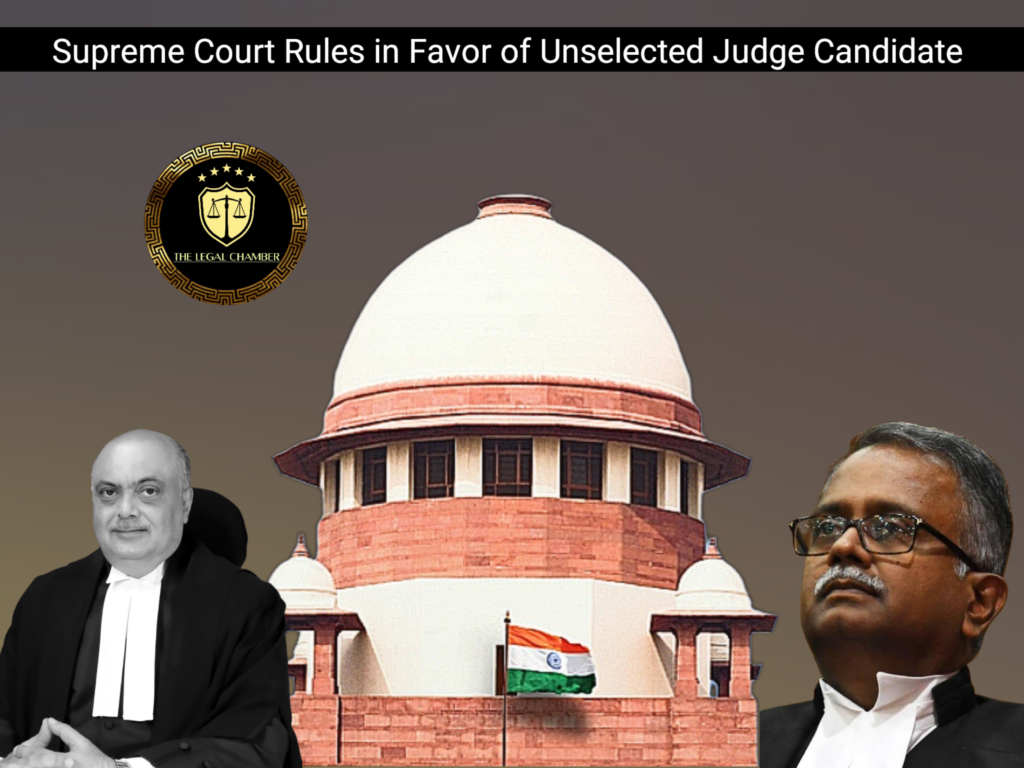
The Supreme Court ruled that Rule 8(2) of the Uttar Pradesh Higher Judicial Service Rules, 1975, applies only when the number of eligible candidates is less than the advertised vacancies. Since one recommended candidate was rejected, the next eligible candidate (appellant) should have been appointed instead of carrying forward the vacancy. The Court emphasized strict adherence to statutory rules in judicial appointments, reinforcing that vacancies must be filled from the existing merit list unless rules explicitly permit otherwise. The judgment clarifies that “selected direct recruits available for appointment” includes candidates next in line if recommended candidates are not approved.
Facts Of The Case:
The case involved Tosh Kumar Sharma, who participated in the 2016 recruitment process for the Uttar Pradesh Higher Judicial Service (UPHJS). The advertisement notified 37 vacancies in the General Category. Sharma secured Rank 38 in the final merit list, but since only the top 37 candidates were initially recommended, he was not selected. However, one of the recommended candidates was later rejected by the Governor of Uttar Pradesh, leaving one vacancy unfilled. Instead of offering the position to Sharma as the next eligible candidate, the High Court’s Selection Committee decided to carry forward the vacancy to the next recruitment cycle under Rule 8(2) of the UPHJS Rules, 1975.Sharma challenged this decision, arguing that the vacancy should have been filled from the existing merit list, as Rule 8(2) applies only when there are insufficient eligible candidates—not when a recommended candidate is rejected. The High Court dismissed his plea, prompting an appeal to the Supreme Court. The key issue was whether the unfilled vacancy could be carried forward or if it should have been offered to Sharma. The Supreme Court ruled in Sharma’s favor, holding that the vacancy must be filled from the same selection process since Rule 8(2) was misapplied. The Court directed his appointment, clarifying that such vacancies cannot be arbitrarily deferred.
Procedural History:
The case originated when Tosh Kumar Sharma, having secured Rank 38 in the 2016 Uttar Pradesh Higher Judicial Service (UPHJS) examination, filed a writ petition (Writ-A No. 13979 of 2022) before the Allahabad High Court after being denied appointment despite one of the top 37 recommended candidates being rejected. The High Court dismissed his petition on 22.09.2022, upholding the Selection Committee’s decision to carry forward the vacancy under Rule 8(2) of the UPHJS Rules, 1975. Aggrieved by this decision, Sharma approached the Supreme Court by filing a Special Leave Petition (SLP (C) No. 4605 of 2023), which was converted into Civil Appeal No. [X] of 2025 after leave was granted. The Supreme Court, in its judgment dated 16.07.2025, overturned the High Court’s ruling, holding that Rule 8(2) did not apply to the facts of the case and directed Sharma’s appointment to the unfilled vacancy. The procedural journey thus involved an initial challenge before the High Court, followed by a successful appeal to the Supreme Court, which ultimately settled the legal interpretation of Rule 8(2) in favor of Sharma.
READ ALSO :Supreme Court Verdict : Police Can’t Serve Appearance Notices via WhatsApp
Court Observation:
The Supreme Court made several key observations while delivering its judgment. It emphasized that Rule 8(2) of the UPHJS Rules, 1975, applies only when the number of eligible candidates is insufficient to fill advertised vacancies, not when a recommended candidate is subsequently rejected. The Court noted that the phrase “selected direct recruits available for appointment” in Rule 8(2) must be interpreted to include the next meritorious candidate when an approved candidate drops out. It observed that carrying forward the vacancy was unjustified since the selection process had already identified sufficient qualified candidates. The bench highlighted that the High Court’s interpretation would lead to arbitrary exclusion of deserving candidates and undermine the sanctity of the merit list. Importantly, the Court reaffirmed that judicial appointments must strictly adhere to statutory rules while ensuring fairness to candidates who clear competitive examinations. These observations formed the basis for directing the appellant’s appointment to the unfilled post.
Final Decision & Judgement:
The Supreme Court allowed the appeal and set aside the Allahabad High Court’s impugned judgment. It held that the appellant, Tosh Kumar Sharma, was entitled to be appointed to the unfilled 37th vacancy in the Uttar Pradesh Higher Judicial Service (General Category) arising from the 2016 recruitment process. The Court directed the High Court and State Government to issue Sharma’s appointment letter within two months, with his seniority to be reckoned notionally from the date other candidates from the same selection process were appointed, though without any back wages. The bench clarified that Rule 8(2) of the UPHJS Rules, 1975, was inapplicable to the case since there were sufficient eligible candidates available. The judgment established that when a recommended candidate is rejected, the vacancy must be offered to the next meritorious candidate from the existing selection list rather than being carried forward, ensuring fairness in judicial appointments while maintaining the integrity of the competitive selection process
Case Details:
Case Title: Tosh Kumar Sharma vs. High Court of Judicature at Allahabad & Ors. Citation: [2025] SCC Online SC Civil Appeal No.: Arising out of SLP (C) No. 4605 of 2023) Date of Judgment: 16th July 2025 Judges/Justice Name: Justice Ahsanuddin Amanullah & Justice S.V.N. Bhatti
Download The Judgement Here